
🎨🌈COLORS🎨🌈
Jun 04, 2023Color is everywhere! From vibrant rainbows to the blank artboards in our design apps, it's an essential part of our creative process. But don't worry, my friend, color theory doesn't have to be a daunting challenge. Let me share a little secret with you, sprinkled with a touch of animation. 😉
Welcome to the world of color theory, where the color wheel takes center stage! It's like a magical recipe book filled with formulas that guarantee harmonious color palettes. And guess what? We'll unveil a few tried and trued formulas together, so designing stunning websites and app interfaces becomes a breeze!
Let's start with monochromatic color schemes. Think of it as rocking a single color like a superstar, with variations in saturation and brightness. Want to add a little oomph? Go crazy and try two colors, but don't lose your socks over it! 🌈🌟
Analogous color schemes are besties on the color wheel, standing shoulder to shoulder. Warm colors like orange and yellow, or cooler shades like blue and purple, will have your design party going strong. It's like inviting the perfect guests to dance harmoniously on your screen. 💃🎉
Complementary color schemes are like lovebirds from opposite sides of the color wheel. Think of purple and yellow, partners in crime, ready to rock your designer socks off! Adjust the saturation and brightness to create refined color palettes that will steal the show. 🦜💜💛
But wait, there's more! Split complementary color schemes bring together colors that are neighbors to the lovebirds. Picture a beautiful triangle on the color wheel, showcasing your design prowess. Triadic color schemes add even more magic by forming a captivating trio of evenly spaced colors. Abracadabra! 🎩✨
Now, let's talk about variations. Need a darker color? Crank up the saturation, move away from gray, and get closer to black. Looking for a lighter touch? Lower the saturation, step back from black, and cozy up to gray. With a little drag and drop, you'll have a whole range of shades at your fingertips!
But hey, did you know you can design an entire interface with just one color or hue? That's right, my friend! It's like painting a masterpiece with a single brush. 🖌️
Now, let's dive into some guidelines for choosing the perfect color palette for your user interface. Remember, proper color harmony is key! If you ever need some inspiration, check out colors.co—they've got your back! Your colors should scale and blend seamlessly within your interface and design system. Think multiple shades of gray and low-saturated colors. It's like having a color buffet that's always ready to serve! 🍽️🎨
Oh, and here's a little secret sauce for you: sprinkle your grays and blacks with a hint of your brand color! Pure blacks and grays can be a bit harsh and make you look like an amateur. We know you're a design ninja, so let that brand color shine through! 💫🌟
Remember, it's not just about the color you choose; it's the contrast that steals the show! Contrast creates visual hierarchy, guides the AI's attention, and ensures accessibility. WCAG 2.0 sets the standards, and you want to aim for that double A conformance level. Need to test your text color contrast? Colorable is your new best friend—play around and see if your colors pass with flying colors! 🚀🌈
So, let's start painting
Lorem ipsum dolor sit amet, consectetur adipiscing elit. Cras sed sapien quam. Sed dapibus est id enim facilisis, at posuere turpis adipiscing. Quisque sit amet dui dui.
Stay connected with news and updates!
Join our mailing list to receive the latest news and updates from our team.
Don't worry, your information will not be shared.
We hate SPAM. We will never sell your information, for any reason.

